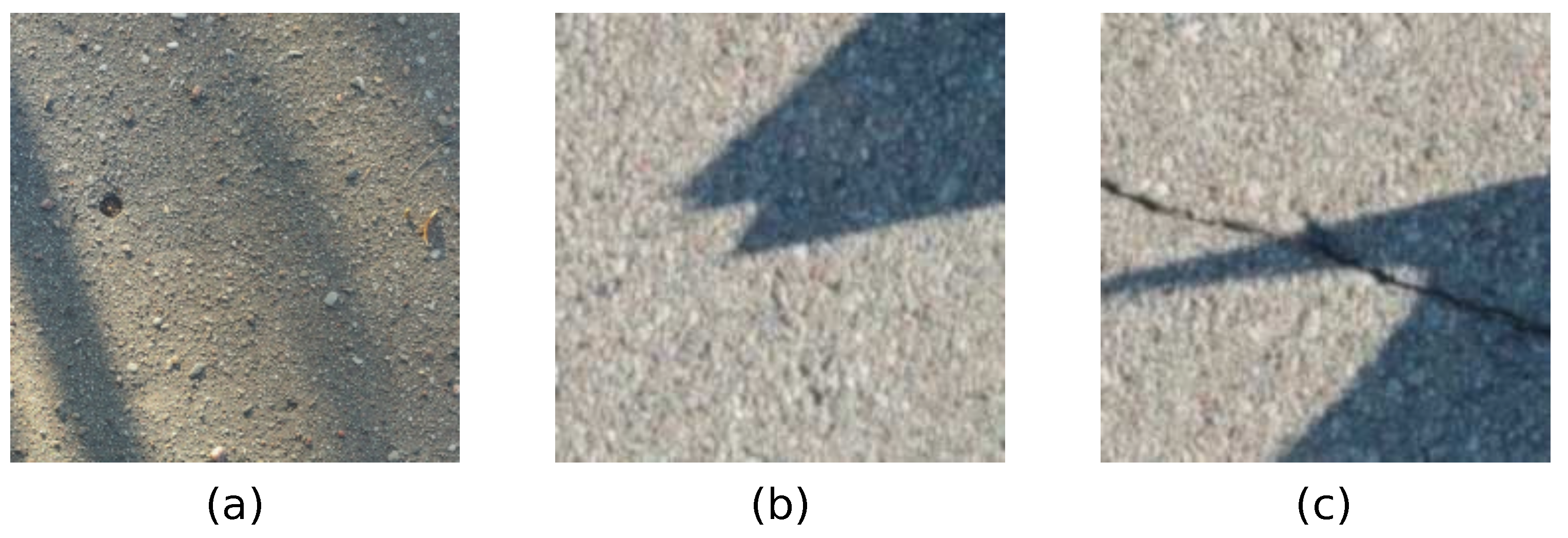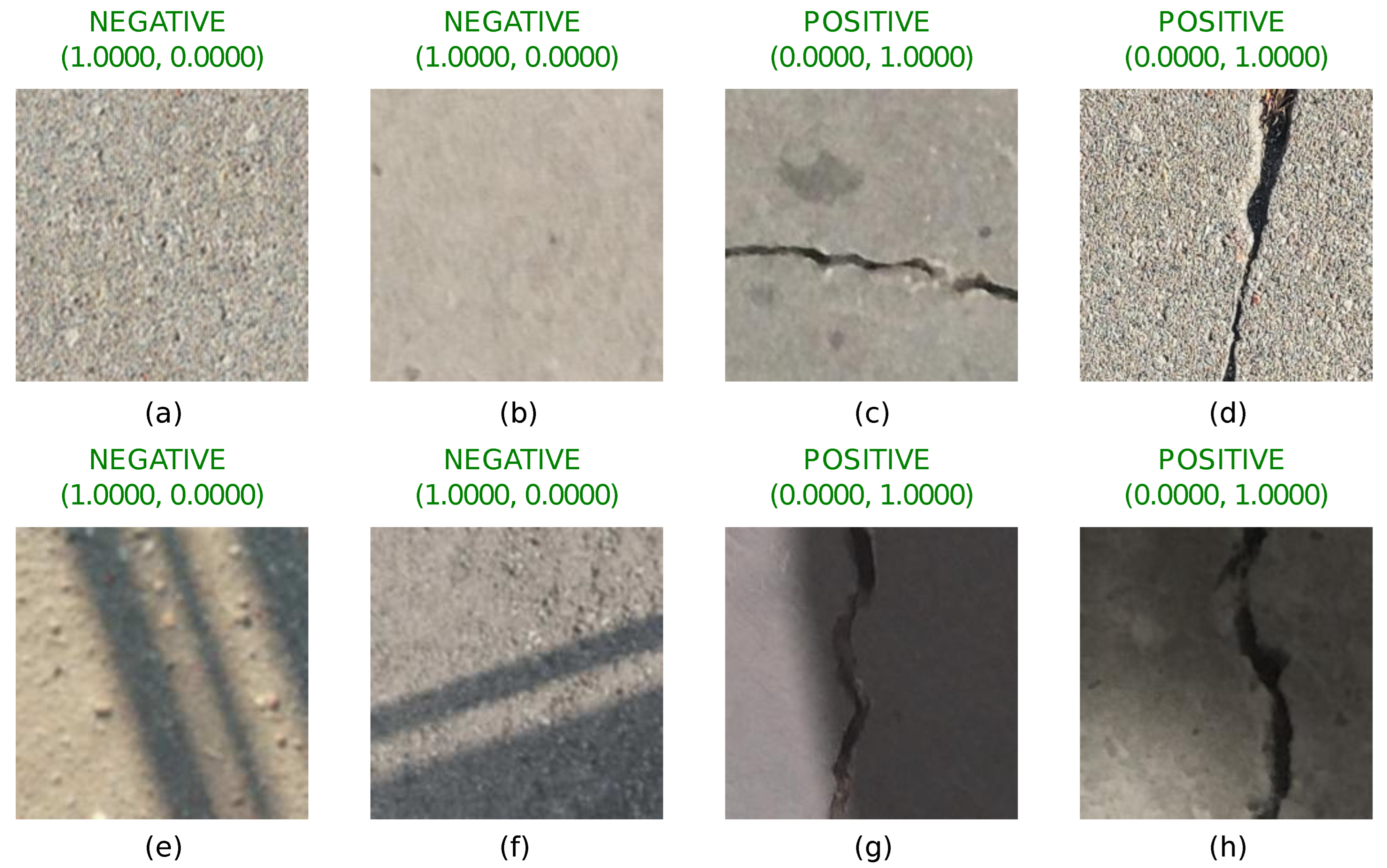Automatic Detection of Cracks on Concrete Surfaces in the Presence of Shadows
Abstract
:1. Introduction
2. Materials and Methods
2.1. Concrete Crack Detection Challenges in the Presence of Shadows
2.2. The Concrete Crack Identification Framework
2.3. The Proposed Shadow Augmentation Technique
2.4. Neural Network for Concrete Crack Detection
3. Results
4. Discussion
5. Conclusions
Author Contributions
Funding
Data Availability Statement
Acknowledgments
Conflicts of Interest
Abbreviations
| NN | Neural Network |
| ANN | Artificial neural network |
| CNN | Convolutional neural network |
| R-CNN | Region-based convolutional neural network |
| LSTM | Long Short-Term Memory |
| SVM | Support vector machine |
| KNN | K-nearest neighbors |
| FCN | Fully convolutional network |
| UAV | Unmanned aerial vehicle |
| DSN | Deeply-Supervised Net |
References
- Budiansky, B.; O’Connell, R. Elastic moduli of a cracked solid. Int. J. Solids Struct. 1976, 12, 81–97. [Google Scholar] [CrossRef]
- Aboudi, J. Stiffness reduction of cracked solids. Eng. Fract. Mech. 1987, 26, 637–650. [Google Scholar] [CrossRef]
- Dhital, D.; Lee, J. A fully non-contact ultrasonic propagation imaging system for close surface crack detection. Exp. Mech. 2012, 52, 1111–1122. [Google Scholar] [CrossRef]
- Mohan, A.; Poobal, S. Crack detection using image processing: A critical review and analysis. Alex. Eng. J. 2018, 57, 787–798. [Google Scholar] [CrossRef]
- Kim, J.J.; Kim, A.R.; Lee, S.W. Artificial Neural Network-Based Automated Crack Detection and Analysis for the Inspection of Concrete Structures. Appl. Sci. 2020, 10, 8105. [Google Scholar] [CrossRef]
- Cha, Y.J.; Choi, W.; Büyüköztürk, O. Deep Learning-Based Crack Damage Detection Using Convolutional Neural Networks. Comput.-Aided Civ. Infrastruct. Eng. 2017, 32, 361–378. [Google Scholar] [CrossRef]
- Jang, K.; Kim, N.; An, Y.K. Deep learning-based autonomous concrete crack evaluation through hybrid image scanning. Struct. Health Monit. 2019, 18, 1722–1737. [Google Scholar] [CrossRef]
- Andrushia, A.D.; Lubloy, E. Deep learning based thermal crack detection on structural concrete exposed to elevated temperature. Adv. Struct. Eng. 2021, 24, 1896–1909. [Google Scholar] [CrossRef]
- Ali, L.; Alnajjar, F.; Jassmi, H.A.; Gocho, M.; Khan, W.; Serhani, M.A. Performance Evaluation of Deep CNN-Based Crack Detection and Localization Techniques for Concrete Structures. Sensors 2021, 21, 1688. [Google Scholar] [CrossRef]
- Choudhary, G.K.; Dey, S. Crack detection in concrete surfaces using image processing, fuzzy logic, and neural networks. In Proceedings of the 2012 IEEE Fifth International Conference on Advanced Computational Intelligence (ICACI), Nanjing, China, 18–20 October 2012; pp. 404–411. [Google Scholar]
- Ha, T.D. Computer vision-based method for concrete crack detection. In Proceedings of the 2016 14th International Conference on Control, Automation, Robotics and Vision (ICARCV), Phuket, Thailand, 13–15 November 2016. [Google Scholar]
- Chen, K.; Yadav, A.; Khan, A.; Meng, Y.; Zhu, K. Improved Crack Detection and Recognition Based on Convolutional Neural Network. Model. Simul. Eng. 2019, 2019, 8796743. [Google Scholar] [CrossRef] [Green Version]
- Cao, W.; Liu, Q.; He, Z. Review of Pavement Defect Detection Methods. IEEE Access 2020, 8, 14531–14544. [Google Scholar] [CrossRef]
- Moon, H.G.; Kim, J.H. Intelligent Crack Detecting Algorithm on the Concrete Crack Image Using Neural Network. In Proceedings of the 28th ISARC, Seoul, Korea, 29 June–2 July 2011; pp. 1461–1467. [Google Scholar] [CrossRef] [Green Version]
- Kim, B.; Cho, S. Image-based concrete crack assessment using mask and region-based convolutional neural network. Struct. Control Health Monit. 2019, 26, e2381. [Google Scholar] [CrossRef]
- Jitendra, M.S.; Srinivasu, P.N.; Shanmuk Srinivas, A.; Nithya, A.; Kandulapati, S.K. Crack detection on concrete images using classification techniques in machine learning. J. Crit. Rev. 2020, 7, 1236–1241. [Google Scholar] [CrossRef]
- Zhang, Y.; Yuen, K.V. Crack detection using fusion features-based broad learning system and image processing. Comput.-Aided Civ. Infrastruct. Eng. 2021, 36, 1568–1584. [Google Scholar] [CrossRef]
- Yang, C.; Chen, J.; Li, Z.; Huang, Y. Structural Crack Detection and Recognition Based on Deep Learning. Appl. Sci. 2021, 11, 2868. [Google Scholar] [CrossRef]
- Finlayson, G.D. Removing Shadows from Images. In Proceedings of the 7th European Conference on Computer Vision, Copenhagen, Denmark, 28–31 May 2002. [Google Scholar]
- Finlayson, G.D. On the Removal of Shadows from Images. IEEE Trans. Pattern Anal. Mach. Intell. 2006, 28, 59–68. [Google Scholar] [CrossRef]
- Murali, S.; Govindan, V.; Kalady, S. A survey on shadow detection techniques in a single image. Inf. Technol. Control 2018, 47, 75–92. [Google Scholar] [CrossRef] [Green Version]
- Khan, S.H.; Bennamoun, M.; Sohel, F.; Togneri, R. Automatic Shadow Detection and Removal from Single Image. IEEE Trans. Pattern Anal. Mach. Intell. 2015, 38, 431–446. [Google Scholar] [CrossRef] [Green Version]
- Wang, J.; Li, X.; Yang, J. Stacked Conditional Generative Adversarial Networks for Jointly Learning Shadow Detection and Shadow Removal. In Proceedings of the IEEE Conference on Computer Vision and Pattern Recognition, Salt Lake City, UT, USA, 18–22 June 2018. [Google Scholar]
- Fan, H.; Han, M.; Li, J. Image Shadow Removal Using End-to-End Deep Convolutional Neural Network. J. Appl. Sci. 2019, 9, 1009. [Google Scholar] [CrossRef] [Green Version]
- Pal, M.; Palevičius, P.; Landauskas, M.; Orinaitė, U.; Timofejeva, I.; Ragulskis, M. An Overview of Challenges Associated with Automatic Detection of Concrete Cracks in the Presence of Shadows. Appl. Sci. 2021, 11, 11396. [Google Scholar] [CrossRef]
- Zgenel, Ç.F.; Sorguç, A.G. Performance Comparison of Pretrained Convolutional Neural Networks on Crack Detection in Buildings. In Proceedings of the ISARC, Berlin, Germany, 20–25 July 2018. [Google Scholar]
- Kim, B.; Cho, S. Automated Vision-Based Detection of Cracks on Concrete Surfaces Using a Deep Learning Technique. Sensors 2018, 18, 3452. [Google Scholar] [CrossRef] [PubMed] [Green Version]
- Krizhevsky, A.; Sutskever, I.; Hinton, G.E. ImageNet Classification with Deep Convolutional Neural Networks. 2017. Available online: https://proceedings.neurips.cc/paper/2012/file/c399862d3b9d6b76c8436e924a68c45b-Paper.pdf (accessed on 10 January 2022).
- Steinmetz, F.; Hofmann, G. The Cycles Encyclopedia. 2014. Available online: https://store.blender.org/product/cycles-encyclopedia/ (accessed on 10 January 2022).
- Jaros, M.; Riha, L.; Karasek, T.; Strakos, P.; Krpelik, D. Rendering in Blender Cycles using MPI and Intel® Xeon Phi™. In Proceedings of the 2017 International Conference on Computer Graphics and Digital Image Processing, Prague, Czech Republic, 2–4 July 2017; Association for Computing Machinery: New York, NY, USA, 2017; pp. 1–5. [Google Scholar]
- Deng, J.; Dong, W.; Socher, R.; Li, L.J.; Li, K.; Fei-Fei, L. Imagenet: A large-scale hierarchical image database. In Proceedings of the 2009 IEEE Conference on Computer Vision and Pattern Recognition, Miami, FL, USA, 20–25 June 2009; pp. 248–255. [Google Scholar]








| Layer No. | Layer Name | Layer No. | Layer Name |
|---|---|---|---|
| 1 | Image input layer | 14 | Convolutional layer |
| 2 | Convolutional layer | 15 | ReLU layer |
| 3 | ReLU layer | 16 | Max-pooling layer |
| 4 | Cross-channel normalization layer | 17 | Fully connected layer |
| 5 | Max-pooling layer | 18 | ReLU layer |
| 6 | Convolutional layer | 19 | Dropout layer |
| 7 | ReLU layer | 20 | Fully connected layer |
| 8 | Cross-channel normalization layer | 21 | ReLU layer |
| 9 | Max-pooling layer | 22 | Dropout layer |
| 10 | Convolutional layer | 23 | Fully connected layer |
| 11 | ReLU layer | 24 | Softmax layer |
| 12 | Convolutional layer | 25 | Classification output layer |
| 13 | ReLU layer |
Publisher’s Note: MDPI stays neutral with regard to jurisdictional claims in published maps and institutional affiliations. |
© 2022 by the authors. Licensee MDPI, Basel, Switzerland. This article is an open access article distributed under the terms and conditions of the Creative Commons Attribution (CC BY) license (https://creativecommons.org/licenses/by/4.0/).
Share and Cite
Palevičius, P.; Pal, M.; Landauskas, M.; Orinaitė, U.; Timofejeva, I.; Ragulskis, M. Automatic Detection of Cracks on Concrete Surfaces in the Presence of Shadows. Sensors 2022, 22, 3662. https://doi.org/10.3390/s22103662
Palevičius P, Pal M, Landauskas M, Orinaitė U, Timofejeva I, Ragulskis M. Automatic Detection of Cracks on Concrete Surfaces in the Presence of Shadows. Sensors. 2022; 22(10):3662. https://doi.org/10.3390/s22103662
Chicago/Turabian StylePalevičius, Paulius, Mayur Pal, Mantas Landauskas, Ugnė Orinaitė, Inga Timofejeva, and Minvydas Ragulskis. 2022. "Automatic Detection of Cracks on Concrete Surfaces in the Presence of Shadows" Sensors 22, no. 10: 3662. https://doi.org/10.3390/s22103662
APA StylePalevičius, P., Pal, M., Landauskas, M., Orinaitė, U., Timofejeva, I., & Ragulskis, M. (2022). Automatic Detection of Cracks on Concrete Surfaces in the Presence of Shadows. Sensors, 22(10), 3662. https://doi.org/10.3390/s22103662








